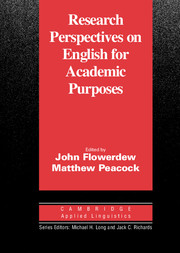Book contents
- Frontmatter
- Contents
- List of contributors
- Series editors' preface
- Preface
- I ISSUES IN ENGLISH FOR ACADEMIC PURPOSES
- II THE ENGLISH FOR ACADEMIC PURPOSES CURRICULUM
- Introduction to Part II
- 11 The EAP curriculum: Issues, methods, and challenges
- 12 Twenty years of needs analyses: Reflections on a personal journey
- 13 The curriculum renewal process in English for academic purposes programmes
- 14 Team-teaching in EAP: Changes and adaptations in the Birmingham approach
- 15 Does the emperor have no clothes? A re-examination of grammar in content-based instruction
- 16 The specialised vocabulary of English for academic purposes
- 17 Language learning strategies and EAP proficiency: Teacher views, student views, and test results
- 18 Issues in EAP test development: What one institution and its history tell us
- 19 Teaching writing for academic purposes
- 20 Reading academic English: Carrying learners across the lexical threshold
- 21 Incorporating reading into EAP writing courses
- 22 The development of EAP oral discussion ability
- 23 Second language lecture comprehension research in naturalistic controlled conditions
- 24 Designing tasks for developing study competence and study skills in English
- 25 Promoting EAP learner autonomy in a second language university context
- References
- Index
14 - Team-teaching in EAP: Changes and adaptations in the Birmingham approach
Published online by Cambridge University Press: 05 October 2012
- Frontmatter
- Contents
- List of contributors
- Series editors' preface
- Preface
- I ISSUES IN ENGLISH FOR ACADEMIC PURPOSES
- II THE ENGLISH FOR ACADEMIC PURPOSES CURRICULUM
- Introduction to Part II
- 11 The EAP curriculum: Issues, methods, and challenges
- 12 Twenty years of needs analyses: Reflections on a personal journey
- 13 The curriculum renewal process in English for academic purposes programmes
- 14 Team-teaching in EAP: Changes and adaptations in the Birmingham approach
- 15 Does the emperor have no clothes? A re-examination of grammar in content-based instruction
- 16 The specialised vocabulary of English for academic purposes
- 17 Language learning strategies and EAP proficiency: Teacher views, student views, and test results
- 18 Issues in EAP test development: What one institution and its history tell us
- 19 Teaching writing for academic purposes
- 20 Reading academic English: Carrying learners across the lexical threshold
- 21 Incorporating reading into EAP writing courses
- 22 The development of EAP oral discussion ability
- 23 Second language lecture comprehension research in naturalistic controlled conditions
- 24 Designing tasks for developing study competence and study skills in English
- 25 Promoting EAP learner autonomy in a second language university context
- References
- Index
Summary
Introduction
The question of whether EAP teaching should be ‘common-core’ or subject specific has always been controversial. In the early days most EAP materials (e.g. Herbert's The Structure of Technical English, The Focus Series) assumed a homogeneous group of students from one discipline, and concentrated on linguistic features of communication in that discipline. Subsequent materials (e.g. Reading and Thinking in English) took account of the fact that many EAP groups are, in fact, heterogeneous with students from a range of disciplines and focused on study skills that were considered to be important whatever discipline one was studying. This position was justified theoretically by the argument that the most important aspects of communication in academic contexts are common to all disciplines and that ESP teaching should not be concerned with teaching ‘specialised varieties’ of English but with the common features (Hutchinson and Waters, 1987). In recent years the increasing evidence from discourse and genre analysis that there is, in fact, significant variation between disciplines in the way that they structure their discourse, both in writing (Myers, 1989; Dillon, 1991) and in academic lectures (Olsen and Huckin, 1990; Dudley-Evans, 1994c), has strengthened the case for the inclusion of some specific work in an EAP programme. The case can also be made on pedagogic grounds. Brinton, Snow and Wesche (1989: 1) argue that simply ‘contextualising’ EAP lessons is not enough and that the basis of EAP teaching should be the authentic texts that students have to handle.
- Type
- Chapter
- Information
- Research Perspectives on English for Academic Purposes , pp. 225 - 238Publisher: Cambridge University PressPrint publication year: 2001
- 19
- Cited by

